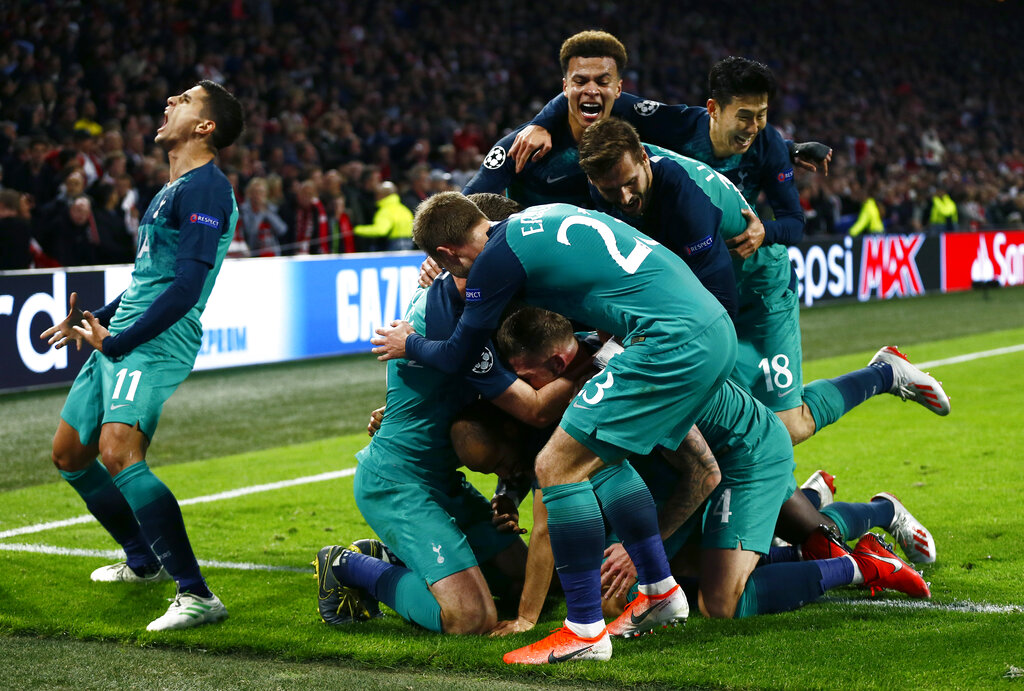
Tottenham players celebrate after scoring their third goal during the Champions League semifinal second leg soccer match between Ajax and Tottenham Hotspur at the Johan Cruyff ArenA in Amsterdam, Netherlands, Wednesday, May 8, 2019. (AP Photo/Peter Dejong)
Ajax’s disconsolate players collapsed to the ground and pressed their faces into the turf. The night before, Barcelona’s startled players looked at each other in pure disbelief , wondering what exactly had happened.
Two Champions League semifinal matches, two three-goal leads squandered.
Astonishing comebacks are becoming the new norm in Europe’s top club competition.
The phenomenon truly started two years ago, when Barcelona recovered from a 4-0 loss to Paris Saint-Germain in the first leg of the last 16 by winning the return 6-1. That surpassed the previous best second-leg comeback in Champions League history from 12 years earlier, which saw Deportivo La Coruna fight back from three goals behind to eliminate AC Milan.
Barcelona has been on the receiving end the past two years, however. If blowing a 4-1 first-leg advantage by then losing 3-0 at Roma in last season’s quarterfinals wasn’t bad enough, Barca lost 4-0 to Liverpool on Tuesday after opening their semifinal with a 3-0 first-leg win.
Inspired by its English rival, Tottenham fought back a day later from a 3-0 aggregate deficit against Ajax to score three second-half goals — the last coming in the sixth minute of stoppage time — to advance on away goals .
Clearly, this never-say-die spirit is becoming contagious amid a spirit of adventure and chaos swirling through the Champions League.
But where has this come from?
ATTACK, ATTACK, ATTACK
Put simply, more goals are being scored in this Champions League era, increasing the likelihood of a comeback and making teams who are trailing believe all is not lost.
In last season’s competition, there were 401 goals at an average of 3.2 per game — rising to 3.6 per game in the knockout stage. It was the highest total since the tournament’s rebrand from the European Cup in 1992.
This season, there have been 89 goals in 28 games in the knockout stage — 3.17 a game.
Barcelona is now a victim of a phenomenon it might have created. The fearless, attacking style in its stellar 2006-11 era of three European titles has been imitated by many teams since.
Attack is now the best form of defense. And look what is happening as a result.
LOST ART OF DEFENDING
Where are those warrior defenders of old, the ones who loved nothing more than backs-to-the-wall efforts?
There are exceptions, of course — Giorgio Chiellini of Juventus and Virgil van Dijk of Liverpool. But defending seems to be a lost art of soccer.
Full backs are now largely a key outlet in a team’s attack. Many center backs are cultured passers rather than obdurate stoppers — see Aymeric Laporte at Manchester City and Clement Lenglet at Barcelona.
How much time do top European teams spend practicing defending? More to the point, why would they when many of their games, domestically and in Europe, are so one-sided given the gulf in finances between soccer’s rich and poor?
RULES CHANGES
It’s the law. There are just 17 sections in the Laws of the Game which govern soccer but they can be modified each year. Changes usually help attacking play.
Ankle injuries which ended the career of the great Netherlands, Ajax and AC Milan forward Marco van Basten at age 28 are cited as inspiring the move to protect creative players in the 1990s. Tackles from behind were punished more quickly and severely. Sliding tackles or with studs raised are now rarer.
Constantly adapting the offside law has helped attackers — a trend accelerated by video review, which was introduced in the Champions League round of 16 in February.
Offside flags are raised less often, letting play develop, because a goal can be disallowed later. Officials want to avoid wrongly stopping promising attacks which means more goal-scoring chances can be created.
Video review has encouraged awarding penalties — in part because slow motion magnifies any incident — and defenders seem more hesitant in the penalty area.
It adds up to more goal-scoring chances and confidence to chase down a lead.
PRESSING PLAY
The slow, methodical play from defense that seemed key to European success decades ago belongs in a museum.
A typically old-school team has not won the Champions League since Inter Milan in 2010.
UEFA’s technical analysis of the last season’s Champions League calls the modern way of harassing defenders close to their own goal “the Guardiola effect.”
Liverpool coach Juergen Klopp’s “heavy metal” brand also stresses quick recovery of the ball and fast-break attacks.
Defenders make more errors in more dangerous positions, so teams know they can score at a faster rate.
UEFA noted last season that “50% of goals were scored as a result of ball-winning in the attacking third.”
Those three-goal leads look less secure.
NEVER SAY DIE
Players can believe in the art of the possible. And because comebacks happened before, they can happen again.
It is no coincidence that English teams, including Manchester United at Paris Saint-Germain in the round of 16, have completed so many comebacks.
British soccer is famed for a fighting spirit demanded by fans who often value passion over technique.
English Premier League teams, wealthier than most European rivals, now have a feared blend: imported coaches and players with global soccer smarts operating in their adopted country’s fast, aggressive style.
Even Barcelona could not cope with a Liverpool team lacking key players yet roared on by an intimidating Anfield crowd. Anything seemed possible.